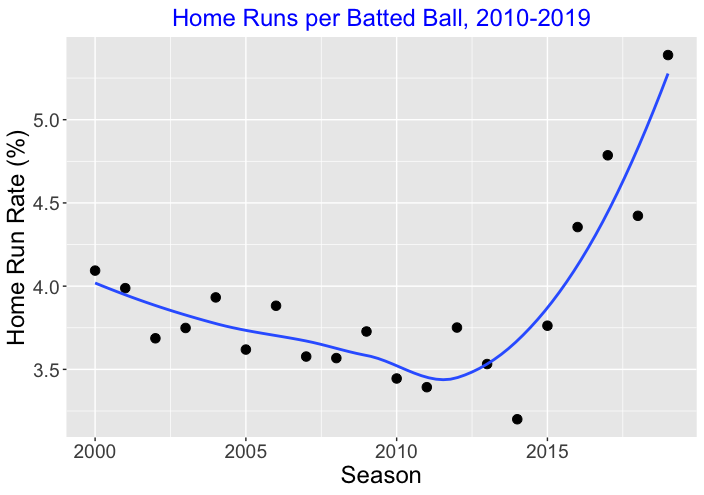The Home Run Surge

Yearly home runs per batted ball during the period 2000-2019 along with a smooth trendline.
Phase I, 2015-2017: Report of the Committee Studying Home Run Rates in Major League Baseball
This is a link (pdf) to the report of the committee tasked by the Office of the Commissioner of Baseball to identify the causes of the increase in home run rates in the 2015, 2016, and 2017 seasons. The report is quite lengthy, although the principal findings and recommendations are summarized on the first few pages, in addition to a list and brief biosketch of the committee members. The principal findings are as follows:
- The increase in home runs was due nearly entirely to a change in the aerodynamic properties of the ball (reduced air drag), meaning that for given launch conditions (exit velocity, launch angle, etc.) the ball travels further, resulting in more home runs. It was determined that the home run increase was not due to changes in the launch conditions.
- With a variety of techniques, including both analysis of Statcast data and laboratory experiments, it was further determined that, in any given year, the ball-to-ball variation of the drag on the baseball is much larger than the relatively small amount of year-to-year change in the average drag that accounts for the increase in home runs.
- Finally, neither the year-to-year changes in the drag nor the significant ball-to-ball variation in the drag could be associated with any particular property of the ball that could be measured in the laboratory nor could these factors be explained by any changes to the manufacturing process.
Other links of interest:
- MLB Press Release
- Key Takeaways from MLB Study of HR Rates, by Anthony Castrovince, MLB.com.
- Full interview on MLB Network, May 25, 2018.
Phase II, 2016-2019: Preliminary Report of the Committee Studying Home Run Rates in MLB
This is a link (pdf) to the preliminary report (released December 11, 2019) of the committee tasked by the Office of the Commissioner of Baseball to identify the causes of the increase in home run rates in the 2016-2019 seasons. The report is more brief than the 2018 report. The methodology employed was similar to that used in the earlier study, with several improvements. First was the development of improved instrumentation for laboratory testing of large samples of baseballs in order to have the needed precision for measuring small effects. Second was improved techniques for modeling of Statcast data, allowing better separation of launch effects from aerodynamic effects. A transcript of the press conference accompanying the release of the report can be found here. The principal findings are as follows:
- Unlike the 2015-2017 increase, the 2017-2019 changes were due to the combined effects of changes in launch conditions and changes in drag. The change in home runs in 2018 was due to two partially cancelling effects: a change in launch conditions which would have increased home runs and an increase in drag. The latter dominated, resulting in an overall decrease. The increase in home runs in 2019 was due to changes in both launch conditions contributing 35% of the change,, and a decrease in drag, contributing the remaining 65%.
- No evidence was found that changes to launch conditions were due to any change in the ball, in particular, to a change in the COR. Instead, it is likely due to change in batter behavior.
- The improved laboratory measurements showed that about 35% of the ball-to-ball variation in drag are due to a change in seam height. The cause of the remaining 65% of the variation in drag is still not known, although various effects (e.g., the thickness of the cotton threads) have been ruled out.
- As with the previous study, the changes to the ball could not be explained by any changes to the manufacturing process.
Incomplete list of links to other research or commentary
- The Baseball is Juiced (Again), Rob Arthur, Baseball Prospectus, April 5, 2019.
- Yes, the Baseball is Different — Again. An Astrophysicist Examines This Year's Baseballs and Breaks Down the Changes, Meredith Wills, The Athletic, June 25, 2019.
- Baseball Aerodynamics, the website of Bart Smith, who has done significant work related to the aerodynamics of a baseball, particulaly the role of the seams.
- The Home Run Committee’s Latest Report Isn’t the Final Word on Juiced Baseballs, Jay Jaffe, Fangraphs, December 12, 2019.



